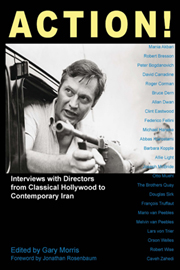Book contents
- Frontmatter
- Contents
- Foreword, by Jonathan Rosenbaum
- Editor's Preface
- Acknowledgements
- Introduction: The Art and Craft of Interviewing
- I Going Hollywood: Masters of Studio Style
- 1 Angel in Exile: Allan Dwan
- 2 “An Unhappy Happy End”: Douglas Sirk
- 3 Somebody Up There Likes Me: Robert Wise
- 4 “The Greatest Movie the World Has Never Seen”: Peter Bogdanovich and Joseph McBride on Orson Welles' The Other Side of the Wind
- 5 “Plant Your Feet and Tell the Truth”: Clint Eastwood
- II Tickets to the Dark Side: Festival Favorites
- III Blows Against the Empire: Indie Godfathers
- IV Edgeplay: Avant-Garde Auteurs
- V Women in Revolt: Artist-Activists
- VI The Canon: Brilliance without Borders
- Contributor Biographies
3 - Somebody Up There Likes Me: Robert Wise
from I - Going Hollywood: Masters of Studio Style
Published online by Cambridge University Press: 05 March 2012
- Frontmatter
- Contents
- Foreword, by Jonathan Rosenbaum
- Editor's Preface
- Acknowledgements
- Introduction: The Art and Craft of Interviewing
- I Going Hollywood: Masters of Studio Style
- 1 Angel in Exile: Allan Dwan
- 2 “An Unhappy Happy End”: Douglas Sirk
- 3 Somebody Up There Likes Me: Robert Wise
- 4 “The Greatest Movie the World Has Never Seen”: Peter Bogdanovich and Joseph McBride on Orson Welles' The Other Side of the Wind
- 5 “Plant Your Feet and Tell the Truth”: Clint Eastwood
- II Tickets to the Dark Side: Festival Favorites
- III Blows Against the Empire: Indie Godfathers
- IV Edgeplay: Avant-Garde Auteurs
- V Women in Revolt: Artist-Activists
- VI The Canon: Brilliance without Borders
- Contributor Biographies
Summary
I have been thinking a lot about Robert Wise (1914–2005) lately, partly because he is one of Hollywood's most underrated directors–hardly acknowledged as a true “auteur”–and partly because so much of his work falls into the genre that interests me most at this time: film noir.
The virtues of Wise's Star Trek: The Motion Picture (1979) became apparent when it was issued in a widescreen video version. Unfortunately, when the film was originally released, the virtues of the director's vision were completely eclipsed by viewers' feelings about the Star Trek television series.
Viewed now–independent of one's previous attitudes toward Captain Kirk and Mr. Spock–Star Trek is an impressive achievement. It is a classic example of what Raymond Durgnat calls “a compass and protractor film,” in which the sheer interplay of abstract colors, forms, and motion is consistently pleasing to the eye; and Wise, apparently, was given plenty of room to indulge his penchant for abstract exercises of this sort. For example, a sequence whose only narrative significance can be summarized in the words, “Kirk returns to his ship,” is elaborated by Wise into a six-minute tour de force of music, composition, and montage.
But, as in most of Wise's best work, the tendency toward abstract formalism is balanced by reserves of feeling. Here, most of the feelings cluster around the film's “monster,” an enormous thinking machine attempting to evolve into human form (specifically, the form of beautiful Indian actress Persis Khambatta), and the reciprocal feelings of one of the crew members (Stephen Collins) toward this pseudo-human.
- Type
- Chapter
- Information
- Action! , pp. 39 - 64Publisher: Anthem PressPrint publication year: 2009
- 1
- Cited by



